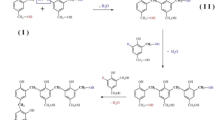Abstract
A study on the development of glass-like carbon from phenol formaldehyde resins employing monohydric (simple) and dihydric phenols (resorcinol and catechol) has been made. It is revealed that to obtain a good glass-like carbon, the optimum molar ratio of formaldehyde to resorcinol in the resorcinol formaldehyde resin is 1.5, as was found earlier in the case of a simple phenol formaldehyde resin, whereas for catechol formaldehyde resin, the optimum molar ratio of formaldehyde to catechol is found to be 2.0. Further, it is observed that the three types of resins lead to glass-like carbons of essentially the similar characteristics, except that the catechol formaldehyde based carbons possess the highest strength of 326 M Pa. A mechanism has been proposed on the basis of three types of phenolic rings designated as attached, bridging and cross-linking, in the structure of the three cured phenol formaldehyde resins to explain the respective optimum molar ratio of formaldehyde to type of phenol.
Similar content being viewed by others
References
S. Yamada andH. Sato,Nature 193 (1962) 261.
H. W. Davidson,Nucl. Engng 7 (1962) 159.
S. Yamada, H. Sato andT. Ishii,Carbon 2 (1964) 253.
J. C. Lewis, B. Redfern andF. C. Cowlard,Solid State Electron. 6 (1963) 251.
F. C. Cowlard andJ. C. Lewis,J. Mater. Sci. 2 (1967) 507.
T. Ishikawa, H. Teranishi andH. Honda, paper presented at 8th Carbon Conference, June 1967, Buffalo, USA.
D. W. McKee,Ann. Rev. Mater. Sci. 3 (1973) 195.
T. Ishikawa andT. Nagaoki, “Recent Carbon Technology, including Carbon and Silicon Carbide Fibres”, edited by I. C. Lewis (JEC, Japan, 1983).
S. Yamada, DCIC report 68-2, April 1968, Battelle Memorial Institute, Ohio, USA.
Brit. Pat. 956452 (1964).
E. Fitzer, W. Schaefer andS. Yamada,Carbon 7 (1969) 643.
E. Fitzer andW. Schaefer,ibid. 8 (1970) 353.
G. M. Jenkins andK. Kawamura, “Polymeric Carbon-Carbon Fibre, Glass and Char” (Cambridge University Press, Cambridge, 1976).
G. M. Jenkins andR. A. Jones,High Temp.-High Pressure 9 (1977) 137.
G. Bhatia, R. K. Aggarwal, M. Malik andO. P. Bahl, Proceedings First Indian Carbon Conference 15–17 December, 1982 (Indian Carbon Society, New Delhi, 1984) p. 352.
G. Bhatia, R. K. Aggarwal, M. Malik andO. P. Bahl,J. Mater. Sci. 19 (1984) 1022.
M. Malik, R. K. Aggarwal, G. Bhatia andO. P. Bahl, Extended Abstracts, International Carbon Conference (Carbone 84), Bordeaux, France, 2–6 July, 1984 (French Carbon Society, 1984) p. 454.
F. W. Billimayer, “Text-book of Polymer Science” (Interscience, New York, 1962).
K. Ouchi andH. Honda,Fuel 38 (1959) 429.
S. J. Mitchell, R. S. PickeringandC. R. Thomas,J. Appl. Polym. Sci. 14 (1970) 175.
Author information
Authors and Affiliations
Rights and permissions
About this article
Cite this article
Aggarwal, R.K., Bhatia, G., Bahl, O.P. et al. Development of glass-like carbon from phenol formaldehyde resins employing monohydric and dihydric phenols. J Mater Sci 23, 1677–1684 (1988). https://doi.org/10.1007/BF01115707
Received:
Accepted:
Issue Date:
DOI: https://doi.org/10.1007/BF01115707




